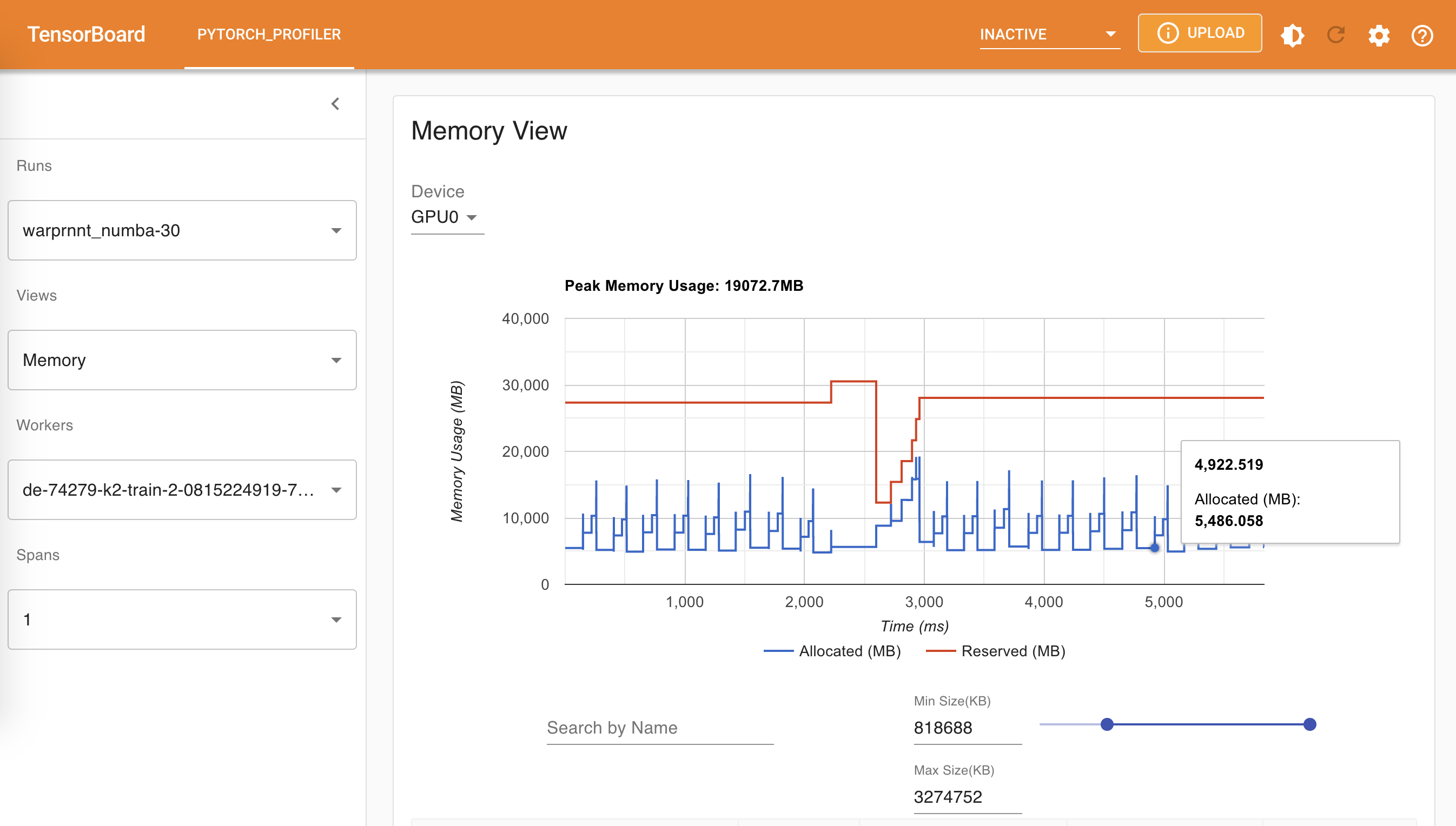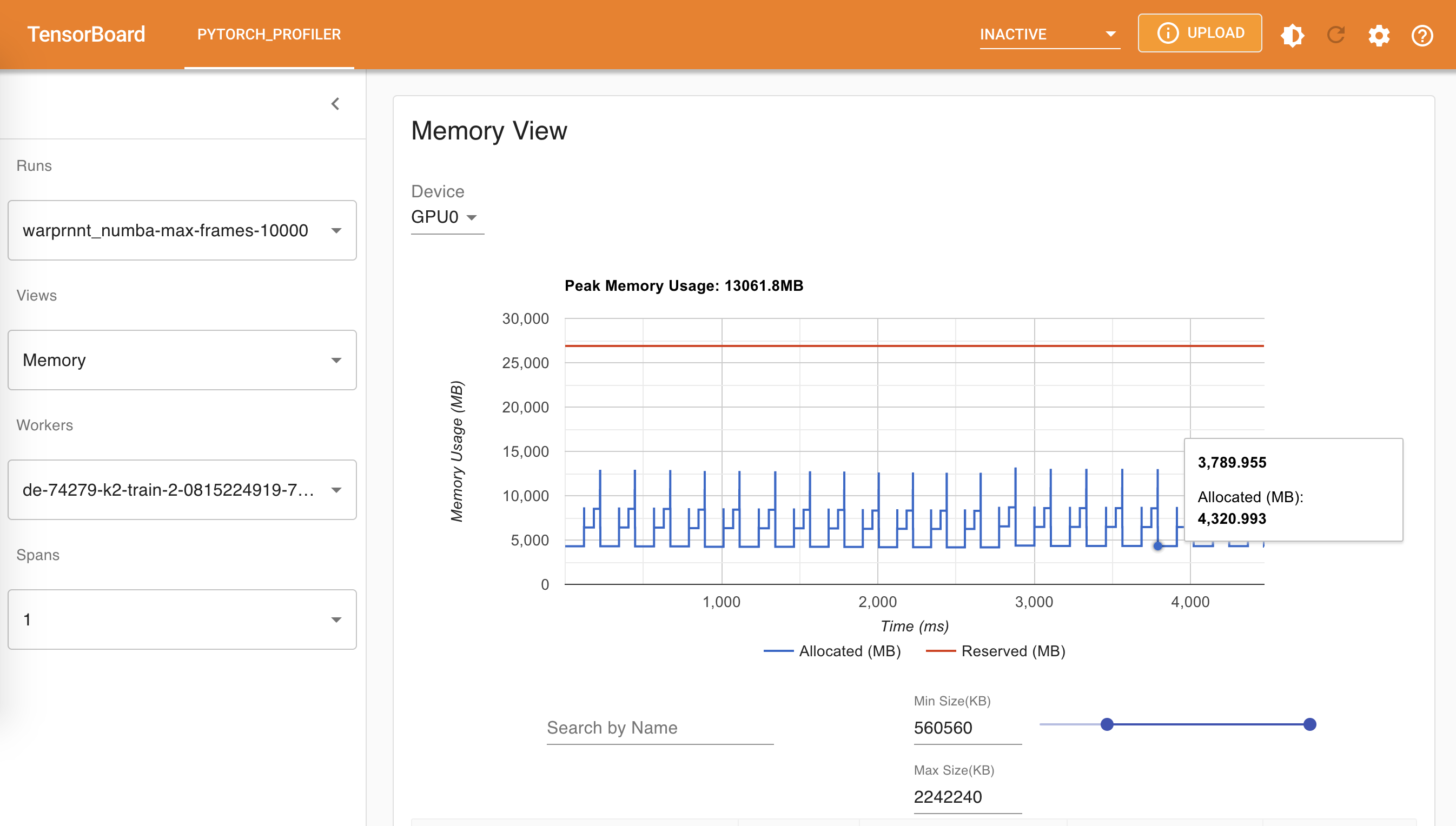This repo tries to benchmark the following implementations of transducer loss in terms of speed and memory consumption:
The benchmark results are saved in https://huggingface.co/csukuangfj/transducer-loss-benchmarking
WARNING: Instead of using warp-transducer from https://github.com/HawkAaron/warp-transducer, we use a version that is used and maintained by ESPnet developers.
Please refer to https://github.com/pytorch/audio to install torchaudio.
Note: It requires torchaudio >= 0.10.0.
Please refer to https://k2-fsa.github.io/k2/installation/index.html to install k2.
Note: It requires at k2 >= v1.13.
pip install optimized_transducerPlease refer to https://github.com/csukuangfj/optimized_transducer for other alternatives.
pip install --upgrade git+https://github.com/titu1994/warprnnt_numbaPlease refer to https://github.com/titu1994/warprnnt_numba for more methods.
git clone --single-branch --branch espnet_v1.1 https://github.com/b-flo/warp-transducer.git
cd warp-transducer
cd build
cmake -DCMAKE_BUILD_TYPE=Release ..
make -j warprnnt
cd ../pytorch_binding
# Caution: You may have to modify CUDA_HOME to match your CUDA installation
export CUDA_HOME=/usr/local/cuda
export C_INCLUDE_PATH=$CUDA_HOME/include:${C_INCLUDE_PATH}
export CPLUS_INCLUDE_PATH=$CUDA_HOME/include:${CPLUS_INCLUDE_PATH}
python3 setup.py build
# Then add /path/to/warp-transducer/pytorch_binding/build/lib.linux-x86_64-3.8
# to your PYTHONPATH
export PYTHONPATH=/ceph-fj/fangjun/open-source-2/warp-transducer/pytorch_binding/build/lib.linux-x86_64-3.8:$PYTHONPATH
# To test that warp-transducer was compiled and configured correctly, run the following commands
cd $HOME
python3 -c "import warprnnt_pytorch; print(warprnnt_pytorch.RNNTLoss)"
# It should print something like below:
# <class 'warprnnt_pytorch.RNNTLoss'>
# Caution: We did not used any **install** command.git clone https://github.com/1ytic/warp-rnnt
cd warp-rnnt/pytorch_binding
# Caution: You may have to modify CUDA_HOME to match your CUDA installation
export CUDA_HOME=/usr/local/cuda
export C_INCLUDE_PATH=$CUDA_HOME/include:$CUDA_HOME/targets/x86_64-linux/include:$C_INCLUDE_PATH
export CPLUS_INCLUDE_PATH=$CUDA_HOME/include:$CUDA_HOME/targets/x86_64-linux/include:$CPLUS_INCLUDE_PATH
python3 setup.py build
python3 setup.py install
# To test that warp-rnnt was installed correctly, run the following commands:
cd $HOME
python3 -c "import warp_rnnt; print(warp_rnnt.RNNTLoss)"
# It should print something like below:
# <class 'warp_rnnt.RNNTLoss'>Caution: You don't need to install SpeechBrain. We have saved the file that is for computing RNN-T loss into this repo using the following commands:
wget https://raw.githubusercontent.com/speechbrain/speechbrain/develop/speechbrain/nnet/loss/transducer_loss.py
mv transducer_loss.py speechbrain_rnnt_loss.py
echo "# This file is downloaded from https://raw.githubusercontent.com/speechbrain/speechbrain/develop/speechbrain/nnet/loss/transducer_loss.py" >> speechbrain_rnnt_loss.pyNote: You need to install numba in order to use SpeechBrain's RNN-T loss:
pip instal numbapip install torch-tb-profilerPlease refer to https://github.com/pytorch/kineto/tree/main/tb_plugin for other alternatives.
git clone https://github.com/csukuangfj/transducer-loss-benchmarking.gitSince padding matters in transducer loss computation, we get the shape information
for logits and targets from the subset train-clean-100 of the LibriSpeech
dataset to make the benchmark results more realistic.
We use the script https://github.com/k2-fsa/icefall/blob/master/egs/librispeech/ASR/prepare.sh
to prepare the manifest of train-clean-100. This script also produces a BPE model with vocabulary
size 500.
The script ./generate_shape_info.py in this repo generates a 2-D tensor, where each row has 2 columns
containing information abut each utterance in train-clean-100:
- Column 0 contains the number of acoustic frames after subsampling, i.e., the
Tin transducer loss computation - Column 1 contains the number of BPE tokens, i.e., the
Uin transducer loss computation
Hint: We have saved the generated file ./shape_info.pt in this repo so you don't need
to run this step. If you want to do benchmarks on other dataset, you will find ./generate_shape_info.py
very handy.
We have the following benchmarks so far:
| Name | Script | Benchmark Result folder |
|---|---|---|
torchaudio |
./benchmark_torchaudio.py |
./log/torchaudio-30 |
optimized_transducer |
./benchmark_ot.py |
./log/optimized_transducer-30 |
k2 |
./benchmark_k2.py |
./log/k2-30 |
k2 pruned loss |
./benchmark_k2_pruned.py |
./log/k2-pruned-30 |
warprnnt_numba |
./benchmark_warprnnt_numba.py |
./log/warprnnt_numba-30 |
warp-transducer |
./benchmark_warp_transducer.py |
./log/warp-transducer-30 |
warp-rnnt |
./benchmark_warp_rnnt.py |
./log/warp-rnnt-30 |
SpeechBrain |
./benchmark_speechbrain.py |
./log/speechbrain-30 |
The first column shows the names of different implementations of transducer loss, the second column gives the command to run the benchmark, and the last column is the output folder containing the results of running the corresponding script.
HINT: The suffix 30 in the output folder indicates the batch size used during the benchmark.
Batch size 30 is selected since torchaudio throws CUDA OOM error if batch size 40 is used.
HINT: We have uploaded the benchmark results to https://huggingface.co/csukuangfj/transducer-loss-benchmarking. You can download and visualize it without running any code.
Note: We use the following command for benchmarking:
prof = torch.profiler.profile(
activities=[ProfilerActivity.CPU, ProfilerActivity.CUDA],
schedule=torch.profiler.schedule(
wait=10, warmup=10, active=20, repeat=2
),
on_trace_ready=torch.profiler.tensorboard_trace_handler(
f"./log/k2-{batch_size}"
),
record_shapes=True,
with_stack=True,
profile_memory=True,
)The first 10 batches are skipped for warm up, the next 10 batches are ignored, and the subsequent 20 batches are used for benchmarking.
You can use tensorboard to visualize the benchmark results. For instance, to visualize
the results for k2 pruned loss, you can use
tensorboard --logdir ./log/k2-pruned-30 --port 6007| Name | Overview | Memory |
|---|---|---|
| torchaudio |  |
 |
| k2 |  |
 |
| k2 pruned |  |
 |
optimized_transducer |
 |
 |
warprnnt_numba |
 |
 |
warp-transducer |
 |
 |
warp-rnnt |
 |
 |
SpeechBrain |
 |
 |
The following table summarizes the results from the above table
| Name | Average step time (us) | Peak memory usage (MB) |
|---|---|---|
torchaudio |
544241 | 18921.8 |
k2 |
386808 | 22056.9 |
k2 pruned |
63395 | 3820.3 |
optimized_transducer |
376954 | 7495.9 |
warprnnt_numba |
299385 | 19072.7 |
warp-transducer |
275852 | 19072.6 |
warp-rnnt |
293270 | 18934.3 |
SpeechBrain |
459406 | 19072.8 |
Some notes to take away:
- For the unpruned case,
warp-transduceris the fastest whileoptimized_transducertakes the least memory - k2 pruned loss is the fastest and requires the least memory
- You can use a larger batch size during training when using k2 pruned loss
To minimize the effect of padding, we also benchmark the implementations by sorting utterances by duration before batching them up.
You can use the option --sort-utterance, e.g., ./benchmark_torchaudio.py --sort-utterance true,
while running the benchmarks.
The following table visualizes the benchmark results for sorted utterances:
| Name | Overview | Memory |
|---|---|---|
| torchaudio |  |
 |
| k2 |  |
 |
| k2 pruned |  |
 |
optimized_transducer |
 |
 |
warprnnt_numba |
 |
 |
warp-transducer |
 |
 |
warp-rnnt |
 |
 |
SpeechBrain |
 |
 |
Note: A value 10k for max frames is selected since the value 11k causes CUDA OOM for k2 unpruned loss. Max frames with 10k means that the number of frames in a batch before padding is at most 10k.
The following table summarizes the results from the above table
| Name | Average step time (us) | Peak memory usage (MB) |
|---|---|---|
torchaudio |
601447 | 12959.2 |
k2 |
274407 | 15106.5 |
k2 pruned |
38112 | 2647.8 |
optimized_transducer |
567684 | 10903.1 |
warprnnt_numba |
229340 | 13061.8 |
warp-transducer |
210772 | 13061.8 |
warp-rnnt |
216547 | 12968.2 |
SpeechBrain |
263753 | 13063.4 |
Some notes to take away:
- For the unpruned case,
warp-transduceris the fastest one optimized_transducerstill consumes the least memory for the unpruned case- k2 pruned loss is again the fastest and requires the least memory
- You can use a larger batch size during training when using k2 pruned loss